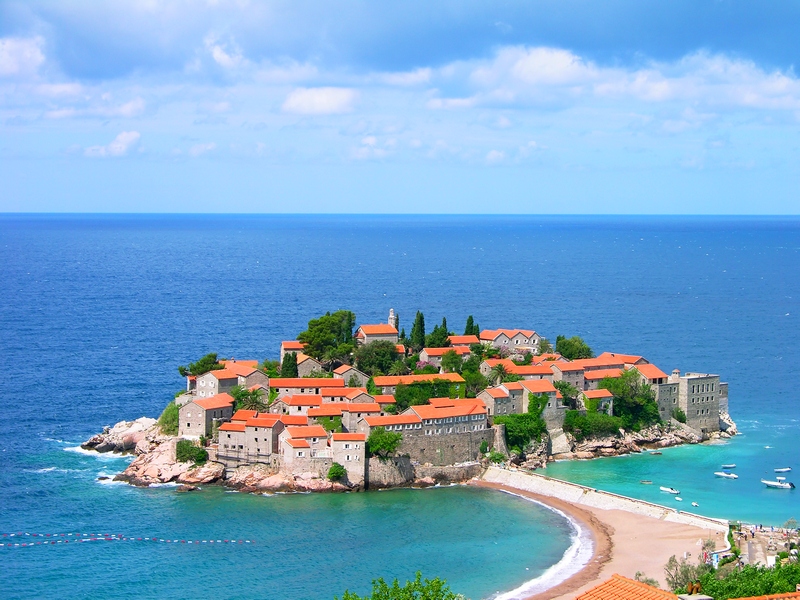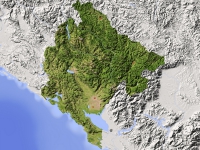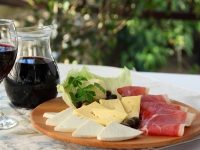About Montenegro
Montenegro's lower areas along the coast enjoy a Mediterranean climate, having dry summers and mild, rainy winters. Central and northern regions have Continental climate, where temperature varies greatly with elevation.
Podgorica, lying near sea level in the valley of the central region, is noted for having the warmest July temperatures in Montenegro, averaging 35-40°C (95-104 F).
Cetinje, in the Karst at an elevation of 670m (2,200 ft), has a temperature 5°C (10 F) lower. January temperatures range from 8°C (46 F) from Bar on the southern coast to -3°C (27 F) in the northern region.
Montenegro's mountainous regions receive some of the highest amounts of rainfall in Europe. In the northern mountains, snow is present throughout the spring.
Cities
* Podgorica – the capital and biggest city in Montenegro, experiencing a huge architectural boom in the last couple of years
* Bečići – with a 2km long fine sandy beach, it is home to numerous resorts and hotels
* Budva – most popular resort with great beaches and vibrant nightlife
* Cetinje – the old royal capital of Montenegro, with a large number of museums, monasteries and former embassies
* Herceg Novi – founded in 1382 and located in the entrance of the Bay of Kotor
* Kotor – an ancient fortified town located deep down the Boka Kotorska bay, UNESCO World Heritage Site
* Nikšić – the second largest city in Montenegro and economically important
* Perast –beautiful small village, a UNESCO World Natural and Historical Heritage Site
* Tivat – a small town in the Bay of Kotor, quickly emerging into a major touristic, business and transport centre
* Žabljak – center of Montenegrin mountain tourism
Other destinations
* Biogradska Gora National Park – some of the last remaining untouched forests in Europe
* Durmitor National Park – rafting through the Tara Canyon, the deepest canyon in Europe, is one of the most popular activities in Montenegro
* Lovćen National Park – beautiful mountain with natural, cultural and historical scenery
* Mount Ostrog – the amazing monastery situated on the almost vertical cliff of Mount Ostrog
* Skadar Lake National Park – the largest lake on the Balkans and the natural habitat of the very diverse flora and fauna
* Sveti Stefan – picturesque town-hotel, a former fishermen town on the small peninsula near Budva (currently closed for renovation)
Get in Montenegro
Holders of travel documents containing a valid Schengen visa, a valid visa of the United States of America or a permission to stay in these countries may enter and stay, i.e. pass through the territory of Montenegro up to seven days, and not longer than the expiry of visa if the period of validity of visa is less than seven days.
To Montenegro by plane
Podgorica airport is Montenegro's main international airport. It is situated 12km (7.5 miles) south of Podgorica. It is a hub for Montenegro's national airline carrier, Montenegro Airlines. One can get from the airport to Podgorica center by taking the minibus, which usually waits in front of the terminal. The taxi to the center will be more expensive, usually at €15. From the city center (Republic Place) to the Airport, metered Taxi costs 10 Euros.
Tivat airport is situated near the city of Tivat, on the Montenegin coast. It has regular flights to Belgrade throughout the year, and has charter flights to major European destinations during the summer. Tivat airport is 20km from Budva and Herceg-Novi and 60 km from Bar.
Dubrovnik airport in Croatia is a half hour drive from the Montenegro border and the coastal city of Herceg-Novi, and is served by many major airlines, so it might be a good option for tourists coming by plane.
To Montenegro by car
European routes E65, E80, E762, E763 and E851 pass through the country. There are no roads in Montenegro built to full motorway standard, as all roads are of single carriageway type. Almost all roads in Montenegro are curvy, mountanious roads, and speeds over 80km/h are not permitted. The general speed limit within a built-up area is 50km/h. Roads in the northern mountanious region require additional caution during the winter. Driving with headlights is obligatory, even during the daytime; so is the use of seat belts.
To Montenegro by sea
There are regular ferry lines from Bar to Bari and Ancona in Italy. Lines operate almost daily throughout the year, and get more frequent during the summer. A trip to Bari takes around 8 hours. A 2 hour trip by ship to Durres, Albania from Ulqin Lines connecting Montenegro with Italy are Bar-Bari and Kotor Bari.
Get around Montenegro by car
As there is no real highway in Montenegro; most roads are two-lane only, with frequent addition of a third overtaking lane. Most roads are curvy and mountainous, so speeds over 80 km/h (50 mph) are rarely legal, and rarely safe. The speed limit is 80km/h on the open road, unless signs specify otherwise. The speed limit inside the cities is 50km/h. The use of safety belts and headlights during the day is compulsory, and the use of cellphones while driving is prohibited. Signposts used in Montenegro are almost identical to those used in EU countries.
Specific road infrastructure in Montenegro
Roads from Podgorica to Bar and to Niksic are good and easy to drive on.
The roads from Podgorica through Cetinje to Budva and to Petrovac are both in good condition, but are curvy mountainous roads which rarely permit speeds over 70km/h.
The road from Podgorica north to Kolasin, and then on to Zabljak or Serbia, is considered dangerous during the winter, especially the part through the Moraca canyon. It is recommended that one takes the bus to the north during the cold or rainy days, as bus drivers are experienced and know the road.
The old road from Cetinje to Kotor is mostly a narrow one-lane road offering stunning views of Kotor from above, but exercise extreme caution when passing on-coming traffic, over-taking and around corners.
Language in Montenegro
The official language is Montenegrin. It is essentially the same language as Serbian, Croatian and Bosnian. In some municipalities with an Albanian majority (Ulcinj, Plav, Gusinje) and the Malesia district in Podgorica municipality, the Albanian is commonly spoken. Slovenian and Macedonian are also understood. Even though their languages are virtually identical, people still distinguish between the Montenegrin, Serb, Croat and Bosniak ethnicities, Montenegrins forming a slight majority. Montenegrin, while found written in both Cyrillic and Latin forms, Latin text is found to be much more common in usage than in neighboring Serbia and the Serbian portion of Bosnia.
In Podgorica and the coastal area, many people speak English. Older people sometimes have a working knowledge of German. Italian also comes very handy, especially along the coast. Russian, which belongs to the same family of Slavic languages, is also heard.
The Riviera of Montenegro
The Bay of Kotor is probably one of the prettiest bays in the world. On its deepest point lies the equally stunning town of Kotor, a beautifully preserved fortified, Medieval town with a vibrant history. Wandering through its labyrinth of narrow and cobblestoned streets, you'll come across lively piazzas, many ancient churches and lots of pleasant bars and restaurants. Don't miss the 12th century St. Tryphon Cathedral, the Church of St. Luke and the Orthodox St Nicholas Church. Kotor is locked between the blue sea on one side, and a dramatically steep cliff on the other. It's a heavy walk uphill, but climbing the 1500 steps will allow you to see the old fortifications on the top as well as provide some amazing views over the bay.
Budva is the country's most popular tourist destination and boast some great beaches as well as a lovely, walled town centre. The old town centre is picturesquely located on a rather small peninsula, and its narrow, winding lanes hide a multitude of historic buildings, churches and small squares. Among the most interesting monuments here are the 7th century St. John's Church, the 8th century Santa Marija of Punta and the 12th century Church of St. Sava. The medieval town fortress is referred to as Citadela and right next to it is the colourful Church of the Holy Trinity, built in 1804. Budav's over 30 km long Riviera has been called 'The Riviera of Sandy Beaches' and is dotted with lovely hamlets and a wealth of historic monuments. A strip of hotels and restaurants separates it from the impressive mountain massifs of Lovcen. From Budva, it's an easy bus ride to the unique Sveti Stefan resort.
The small but gorgeous town of Perast saw some of its best architecture arise in the 17th and 18th century, when it belonged to the Republic of Venice. That typically Venetian, baroque architecture has been wonderfully preserved, with highlights including the Bujovic, Zmajevic, Badovic and Smekja Palaces which were once owned by wealthy maritime captains. All the way in the south, Ulcinj is one of the Adriatic's oldest towns, with a delightful centre and lots of natural beauty around. It also makes a good base from where to explore the old centre of nearby Bar, Lake Skadar or even a cross border visit to Albania. Although less spectacular than nearby Kotor, Herceg Novi (roughly translated as New Castle) is another charming Montenegrin town with a beautiful old centre and a good number of interesting churches, squares and fortresses.
Montenegrin cuisine
Apart from the hotels located in towns and summer resorts offering half-board and full-board accommodation, and those along the roads and communication lines such as restaurants, pizza places, taverns, fast food restaurants and cafes, there is a choice of national restaurants offering traditional Montenegrin cuisine.
In addition to the standard European and Mediterranean cuisine, Montenegro offers a variety of healthy food products and local specialities.
Cold hors-d'oeuvres include the famous njeguški pršut (smoked ham) and njeguški cheese, pljevaljski cheese, mushrooms, donuts and dried bleak. The main courses specific for the northern mountainous region are boiled lamb, lamb cooked in milk, cicvara in fresh milk cream (buttered corn porridge), boiled potatoes with cheese and fresh cream. A selection of traditional recipes of the central and coastal parts will include the kastradina (dried mutton), smoked and fresh carp (from Skadar lake) and a variety of fresh sea fish and seafood dishes. Donuts served with honey and dried figs are traditional desserts in these parts of Montenegro.
Wine production in Montenegro
Montenegrin vineyards and the production of quality wine is part of the tradition of southern and coastal wine makers.
The best known Montenegrin wines are the premium whites: 'Krstač', 'Cabernet', 'Chardonnay' and reds: 'Vranac', 'Pro Corde'. All of them are produced by the famous company 'Plantaže', but there's also some home-made wines of high quality, like Crmničko wine.
1L bottle of 'Vranac' red wine will cost you from €8 to €15 in the bar or restaurant and it is well worth it!
Brandy production in Montenegro
The continental region and north are more oriented towards the production of aromatic fruit flavoured brandy (plum brandy - šljivovica, apple brandy - jabukovača). Grape brandy 'Montenegrin loza', 'Prvijenac', 'Kruna' or home made grape brandy (lozova rakija, lozovača) is a must-try, and a good choice to 'warm up' before going out in the evening.
Beer production in Montenegro
'Nikšićko' beer is the best known beer in the Montenegro, and most common alcoholic beverage, which cost from €0.50 to €2.50. It is produced as a draught beer, or bottled, in both 'Nik Gold' and lighter 'Nik Cool' variant. The dark variant, 'Nik tamno', is praised among beer lovers.





